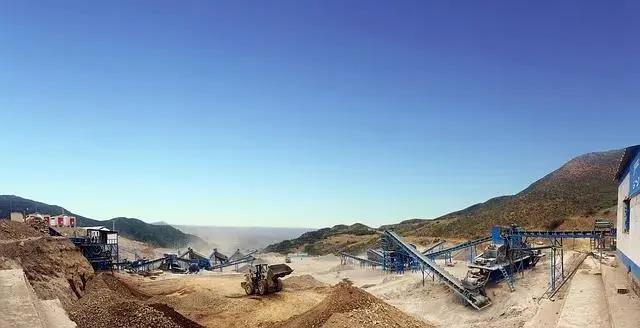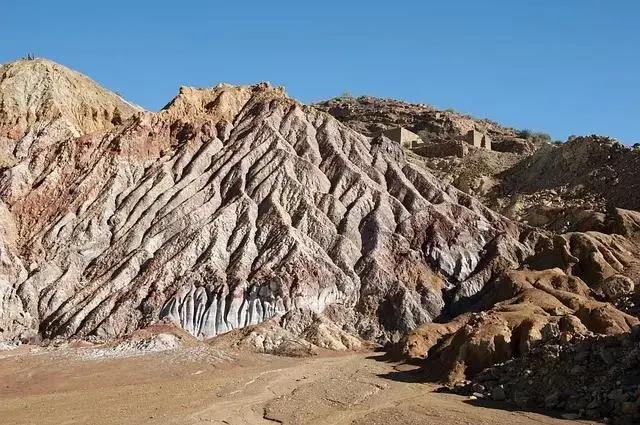

After the epidemic, grasp the six major trends of mining industry and aim at the three major directions, which has great potential!
- Update: 2021-01-18 Views: 304
- With the gradual improvement of the epidemic situation, enterprises in the geological exploration industry have begun to resume work and production. The two-month epidemic situation has made many enterprises start to think about the future development path. Some enterprises are full of confusion about their own future development. We might as well make a calm analysis and comb the development trend of mining together. In recent years, especially after China's economy has entered the new normal, China's mining development has shown some new signs, new trends and new characteristics, and mining will also usher in a new round of development.
Six mining development trends
Trend 1: adjustment and modification of mining regulations and policies
After the 18th National Congress, with China changing the growth mode, promoting the supply side structural reform, "three going, one compensating and one reducing", strengthening the construction of nature reserves and the establishment of national park system, the government put forward clear requirements for the transformation and upgrading of mining industry.
From the perspective of mineral resources management, the state has strengthened the optimization service and Reform in the mining field, gave full play to the decisive role of the market in resource allocation, cancelled and delegated the government's administrative examination and approval items to 56%, and completely cancelled the non administrative licensing items. More than ten administrative regulations and departmental rules on geology and mineral resources management were revised and improved, and the revision of the mineral resources law was launched. Carry out the reform of the transfer system of mining rights, explore and implement the competitive transfer of mining rights, and improve the efficiency of resource allocation. We carried out the reform of the mineral resources equity payment system, and established a new mineral resources equity payment system composed of the income from the transfer of mining rights, the occupation fee of mining rights, and the mine geological environment treatment and restoration fund.
Take the cancellation of non administrative licensing matters as an example, in accordance with the provisions of the negative list of market access issued by the State Council and the new arrangements in the reform plan of mining right transfer system. After 2018, there are only the following restrictions in the field of mineral resources exploration and exploitation: approval and registration of mining rights, approval and registration of exploration rights, qualification conditions for shale gas exploration and exploitation, review and filing of mineral resources reserves and approval of reserves registration, conditions for oil and gas exploration and development, restrictions on rare earth exploration, application for new registration of rare earth and tungsten mining, qualification recognition of gold mining and uranium mining. This means that as long as your company has information and technology, you can obtain the exploration right of the first type, namely risk exploration, by applying first. The main mining administration functions of the land and resources department focus on formulating industry standards and norms, strengthening supervision during and after the event, punishing illegal acts and maintaining market order.
Trend 2: Green has become the basic requirement of Mines
Green is a necessary condition for sustainable development and an important embodiment of people's pursuit of a better life. Adhering to green development, promoting the construction of ecological civilization with resource conservation and promoting the harmonious coexistence between man and nature has always been the main battlefield of land and resources work.
The Ministry of land and resources, the Ministry of finance, the Ministry of environmental protection, the AQSIQ, the CBRC and the CSRC jointly issued the implementation opinions on accelerating the construction of green mines to comprehensively promote the construction of green mines. As an outstanding leader in green mining, molybdenum mining industry will also be a key development object.

Trend 3: strategic minerals will become the support of strategic industries
At present, the breeding and rise of the new industrial revolution and the rapid development of high-tech industries and strategic emerging industries will accelerate the transformation of old and new kinetic energy, drive the consumption of emerging materials and minerals, and release new potential for the revitalization of mining industry. According to the research of relevant experts, in recent years, most developed countries such as the European Union and the United States have formulated a strategic mineral catalogue in line with their own interests and development, including "three rare" minerals and non-metallic minerals without exception. For example, as early as 2010, based on the study of 46 minerals in the world, the European Commission identified 14 minerals as key mineral raw materials, of which 10 were mainly produced in China, including molybdenum, antimony, fluorite, germanium, graphite, rare earth, tungsten, gallium, indium and magnesium; Rand Corporation also released the report on the threat of key and strategic minerals to the U.S. manufacturing industry in 2013, which also identified 14 most needed key strategic mineral raw materials, which are defined as difficult to obtain strategic minerals, of which 11 are mainly from China, including rare earth, molybdenum, tungsten, germanium, graphite, fluorite, antimony, indium, barite, vanadium and magnesium.
In China, in November 2016, the national mineral resources planning (2016-2020) approved by the State Council included 24 kinds of minerals in the strategic mineral catalogue for the first time. These 24 kinds of minerals are: energy minerals, oil, natural gas, shale gas, coal, coalbed methane and uranium; Metal minerals, iron, chromium, copper, aluminum, gold, nickel, tungsten, tin, molybdenum, antimony, cobalt, lithium, rare earth and zirconium; Non metallic minerals, phosphorus, potassium salt, crystalline graphite and fluorite.
With the implementation of the "made in China 2025" strategy, the adjustment of manufacturing structure and the continuous promotion of product upgrading, emerging industries will have an increasing demand for strategic mineral raw materials such as molybdenum, rare earth, cobalt, vanadium and titanium. Obviously, the future market of strategic minerals should not be underestimated.

Trend 4: mine digital intelligence will accelerate
The acceleration of scientific and technological innovation, the cross integration of new technologies such as big data, Internet and remote sensing detection with mining, and the R & D and application of digital and intelligent technologies and equipment have made the new driving force of mining development stronger and stronger, opening up a new field for mining transformation and upgrading and innovative development: the digitization and intelligence of mining.
Digital and intelligent mining refers to taking digital, intelligent and automatic mining equipment as the core, high-speed, high-capacity and two-way comprehensive digital communication network as the carrier, intelligent design and production management software system as the platform, and realizing the safety, efficiency, economy and economic benefit maximization of mine mining through real-time, dynamic and intelligent monitoring and control of mine production objects and processes. The significance of digital and intelligent mining mainly lies in the use of modern high-tech to improve traditional industries, promote the safe, efficient, economic, green and sustainable development of China's mining industry, and enhance the core competitiveness of China's mining industry, which is also the ultimate goal of promoting digital and intelligent mines.
Many mines in China have gradually shifted from shallow mining to deep mining. Due to the differences in resource endowment conditions, mining technology, production process and production equipment of underground mines, as well as the uncertainty and dynamics of resources, the discrete type of workplace, the mobility of productivity factors and the high risk of production environment, many problems have been formed, resulting in low production efficiency and frequent accidents of mining enterprises. In this case, in order to improve the technical strength of China's mines, it is particularly important to carry out the research on mine intelligent mining technology and gradually promote and realize mine intelligent mining.

Trend 5: China's multinational mining enterprises will be active in the world
In recent years, western countries have reintroduced trade protectionism. Mining giants and multinational corporations in western countries have continuously strengthened the merger and monopoly of important mineral resources with their strong capital and long occupied resource territory. In the context of globalization and increasingly fierce competition, being bigger should not be the ultimate goal of the development of China's mining enterprises. On the basis of being bigger, being better and stronger and becoming a world-class large enterprise with global competitiveness can be good at dancing on the global mining stage.
It should be pointed out that the countries along the "the Belt and Road" are rich in mineral resources, with strong consumption demand and active investment transactions. They occupy an important share and position in the value chain of the world's mining industry. Taking mining as a leading industry and giving priority to promoting the cooperation between China and countries along the line in mineral exploration, mining, processing, consumption, mining investment and trading is of great significance to promote the healthy development of China's mining industry.
Trend 6: mining culture leads to higher mining prices
Due to the development and utilization of mineral resources, the Chinese nation has created a splendid mining culture and mining civilization in history, such as ceramic culture, bronze culture and iron smelting culture. It is also this mining civilization that promoted the development of ancient Chinese economy and society, made Chinese civilization always stand in the forefront of world civilization, made great contributions to the progress of human civilization, and became the world-famous four ancient civilizations. In the west, the discovery and use of coal, iron ore and other minerals promoted the first "industrial revolution" (Industrial Revolution) starting from the use of steam engine. Subsequently, the intensity and depth of the development and utilization of mineral resources developed unprecedentedly. The extensive use of mineral resources has promoted the development of modern geology, deposit science and prospecting. In turn, it promotes the exploration and development of mineral resources.
Taking molybdenum ore as an example, the beneficiation of molybdenum in China has a history of half a century. From the only Yangjiazhangzi in old China to now, there are more than 50 different molybdenum concentrators, copper molybdenum concentrators, tungsten molybdenum concentrators and molybdenum bismuth concentrators. In recent years, with the cyclical bottom rebound of molybdenum industry, the price of molybdenum series products has shown a significant upward trend since the low point in June last year. In the first half of 2018, the average price of molybdenum concentrate (45% - 50%) in the domestic market reached 1614 yuan / ton, up 44.75% year-on-year; The average price of ferromolybdenum was 111000 yuan / base ton, up 41.2% year-on-year. After entering the second half of the year, the price focus has further increased. As of August 28, the quotation of Baichuan molybdenum concentrate has reached 1860 yuan / ton degree, and the upward trend of molybdenum price has been established.
Supply tightening superimposed on increased demand, and the upward logic of molybdenum price was established. From the supply side, the international molybdenum resources are mainly associated minerals with limited increment. Due to the low molybdenum price in the past few years, many small and medium-sized molybdenum mines in the domestic molybdenum industry have stopped production, while molybdenum mining, beneficiation and smelting are heavily polluting industries. Under the continuous high pressure of environmental protection supervision, the supply is relatively rigid, the shutdown capacity is difficult to resume production, and the fundamentals of molybdenum supply are becoming more and more tight. From the demand side, after the supply side reform of the iron and steel industry achieved phased results, the profits of the iron and steel industry remained at a high level. Under the background that the total amount was regulated by policies, the industry development turned to the pursuit of the improvement of product added value. Under this background, the output growth of high-performance alloy steel, stainless steel and tool steel containing molybdenum significantly exceeded that of crude steel, and the demand for molybdenum ushered in rapid growth.
PREX:NONE


